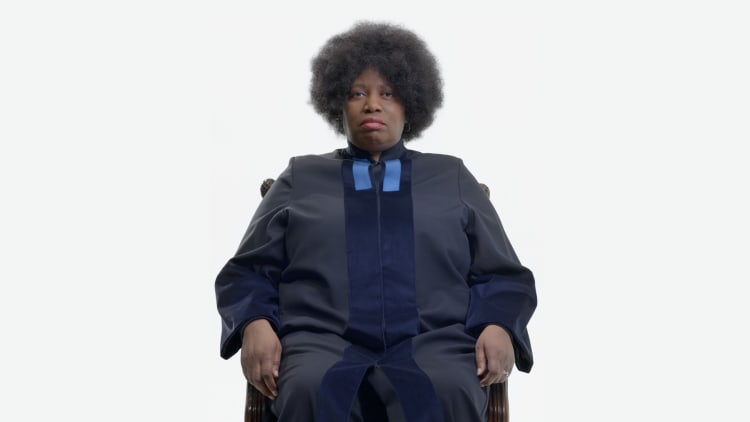
Carey Young, Appearance (2023), HD video (from 4K), silent, 49 mins 30 secs.
Sitting on a bench being stared at by a judge is typically a moment to think hard about prior life choices. While entirely voluntary on the part of exhibition viewers, the experience of Carey Young’s Appearance at Paula Cooper Gallery involves an unsettling confrontation with embodied power.
Taking inspiration from Andy Warhol’s Screen Tests, Young persuaded 15 British judges to come to her studio and pose, statue-like, in an imposing chair. Extended frontal takes with little movement other than blinking are punctuated by extreme close up shots that pan across details both personal and official — hair, jewelry, and manicured fingernails, along with the array of fabrics and trim characterizing their elaborate judicial robes. Young’s decision to focus only on judges who identify as female provides an intriguing perspective on the exercise of judicial power, characterized in the UK by gains in gender and ethnic diversity that remain more pronounced in junior rather than senior ranks.
At certain moments during the titular 49:30-minute video, the close-up vantage point shifts to views showing the full studio setup. This demonstration of the apparatus is fascinating in its own right, but it also draws attention to the remarkable fact that Young convinced this array of powerful individuals to participate. They look at us via the mediation of the camera’s invasive gaze, and their aura of authority — even when placing themselves in a situation of potential vulnerability — is a reminder of their daily visibility as representatives of the state. Their voluntary involvement is also an interesting twist on an earlier work, “Palais de Justice” (2017): shot surreptitiously over several years in the historic Brussels courthouse, Young relied on a legal opinion that judges and lawyers were public figures during trial proceedings and only solicited their agreement to appear in the work after the fact.
Young’s powers of persuasion are equally evident in her ability to talk her way into the various prisons captured in Surfaces of Law, a remarkable series of photographs of interior spaces that only gradually reveal their full implications. A yellow bench cushion with its end propped against the wall in “Cell (for Groups), Police Station, La Rochelle, France” is full of modernist echoes, yet this is the opposite of a Le Corbusier recliner, offering up only 90-degree angles for those confined. In another context — and configuration — the blue hand and shoe prints interrupting the wall and floor of “Intake Room, Police Station, Bruges, Belgium” might seem whimsical, but they are clearly prompts for assuming a position widely associated with police power. A largely discredited claim that pink prison environments have a pacifying effect accounts for the saturated tonalities suffusing “Solitary Confinement Cell, Prison, Basel, Switzerland.” But far more disturbing than evidence of this heavy-handed attempt at social conditioning is an easily overlooked smattering of small rust-colored droplets in the image’s lower left quadrant.
These European prison interiors may seem like a far cry from the conditions of grim deprivation found elsewhere, including parts of the US. Yet Young’s emphasis on surfaces and appearances, in the juxtaposition of figures of authority with spaces of incarceration, urges her audience members to consider what lies beyond, in both systems of justice and conditions of injustice.